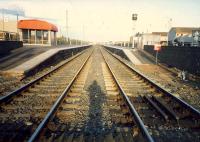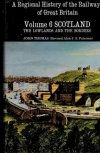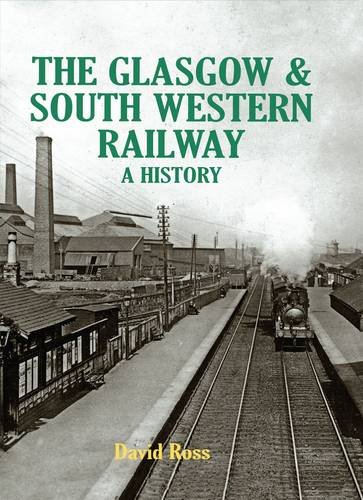Ardrossan and Johnstone Railway
Introduction
This line is partly open. The line was originally a waggonway known as the Ardrossan and Johnstone Railway built in 1831. It was later re-gauged as a railway and re-aligned (eliminating tight curves) when it became the Ardrossan Railway Company in 1839. The line was planned to connect the Glasgow, Paisley and Ardrossan Canal (Glasgow Eglinton Basin to Johnstone Basin only built) to the port at Ardrossan with a railway from Johnstone to Ardrossan. The canal was supported by the Earl of Eglinton (owner and developer of Ardrossan) and the Dixons of the Govan Colliery. The canal's Act was 1806, opened 1811. Its purpose was undermined by improvements to the River Clyde made around the same time, making the river navigable to larger vessels. With the canal never having been extended the plan to complete its route as a railway was promoted. The section of line from Ardrossan to Kilwinning and pits at Doura was opened, however the line was not extended to Johnstone. There was a passenger service between Ardrossan and Kilwinning and a station at Dirrans. Note that the names Glasgow, Paisley and Ardrossan Railway, Ardrossan and Johnstone Railway and Ardrossan Railway were used interchangeably for this railway. For clarity the name Ardrossan and Johnstone Railway has been adopted for the line prior to conversion to standard gauge and Ardrossan Railway afterwards.
Why built
This line was built to connect Glasgow to the extensive new harbour at Ardrossan. It ran alongside (just north of) the existing Ardrossan Waggonway and an earlier short canal at Stevenston.
Architecture
No original buildings survive.
Service
The line carries passenger trains from Ardrossan and Largs to Glasgow. Until recent years coal trains ran from Hunterston to various power stations.
Dates
| 14/06/1827 | Ardrossan and Johnstone Railway Act receives Royal assent. |
| / /1829 | Ardrossan and Johnstone Railway Construction begins. 5.5 mile line from Ardrossan to Kilwinning. The line was a horse-drawn waggonway of gauge 4ft 6in. |
| / /1831 | Ardrossan and Johnstone Railway Opened. Stations opened at: Ardrossan. |
| / /1834 | Ardrossan and Johnstone Railway Extended to Fergushill and Doura. The system was to expand to 22 miles, it served the Eglinton Iron Works and the Doura branch was to be extended south at a later date. |
| / /1834 | Ardrossan and Johnstone Railway Passenger trains start running from Dirrans to Ardrossan. |
| / /1838 | Ardrossan and Johnstone Railway Related service of vessels started from Ardrossan to Liverpool, stopped after six months. |
| / /1839 | Ardrossan and Johnstone Railway Reformed as the Ardrossan Railway for conversion to standard gauge. The change of name may be artificial. |
Route described
The line runs east from Ardrossan Harbour to Kilwinning. The closed portion ran from Dubbs to Eglinton Ironworks, Doura and on to Fergushill. Note that 'Doura' originally referred to large area bordering Kilwinning, but today refers to the area to south.
North of Kilwinning the line was to run west of Dalgarren, crossing the River Garnock at Blair (south of Dalry). However the present route (the former GPK&AR) crosses the River Garnock just north of Kilwinning. This implies that the route north from Kilwinning was not built. From this we might also assume that the line was not curtailed due to the cost of crossing the River Garnock by Kilwinning.
Portions of line and locations
This line is divided into a number of portions.
Ardrossan to Kilwinning
This ran from the west breakwater of Ardrossan Harbour to Kilwinning, roughly the site of the present station. The line carried passengers between these points. It remains open, with a few minor alterations and the removal of industrial sidings.
The western breakwater of Ardrossan Harbour was served by the Ardrossan and Johnstone Railway from an early date. This predates the opening of Ardrossan Winton Pier and Ardrossan Town was a terminus for passenger trains.
...
This is a single platform station, re-opened in 1987. In the past, this was the Glasgow and South Western Railway's main station serving Ardrossan.
...
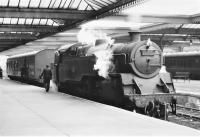
Brian Haslehust 04/04/1964
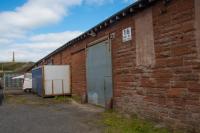
Ewan Crawford 10/08/2017
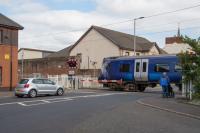
Ewan Crawford 10/08/2017
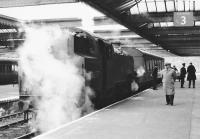
Brian Haslehust 04/04/1964
The original shed at Ardrossan was to the west side of Ardrossan Town, approached from the Kilwinning direction. This was replaced with the newer shed within the triangle of lines at Castlehill. ...
More detailsAt Castlehill Junction, immediately east of Ardrossan Town, the Ardrossan and Johnstone Railway was met by the west fork of the Largs Branch (Glasgow and South Western Railway). The box was located to the north of the junction and opened with the Largs branch in 1878.
...
See also
Largs Branch (Glasgow and South Western Railway)
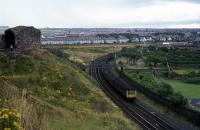
John Clark /08/1976
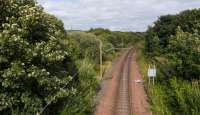
Ewan Crawford 10/08/2017
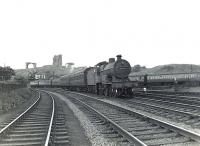
G H Robin collection by courtesy of the Mitchell Library, Glasgow 06/07/1959

R Sillitto/A Renfrew Collection (Courtesy Bruce McCartney) /11/1962
This junction is immediately west of Ardrossan South Beach station. The lines from Glasgow to Ardrossan Harbour and Largs divide here.
...
See also
Largs Branch (Glasgow and South Western Railway)
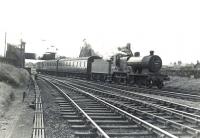
G H Robin collection by courtesy of the Mitchell Library, Glasgow 04/07/1959
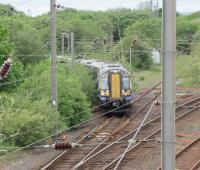
David Panton 22/05/2019
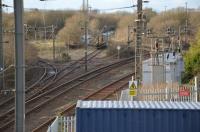
Douglas Blades 09/02/2021
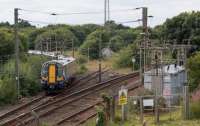
Ewan Crawford 10/08/2017
This is a one platform station, although there are two lines.
...
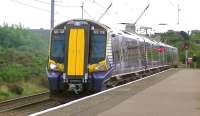
Ken Browne 13/08/2014
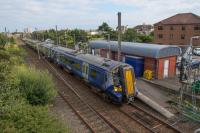
Ewan Crawford 10/08/2017
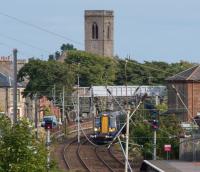
Ewan Crawford 10/08/2017

David Panton 17/10/2018
This is a two platform station with original station buildings on both the up and down platforms. The main building, a long single storey building in red sandstone on the Glasgow bound platform, dates from 1894. It is fitted with a full length glazed canopy.
...
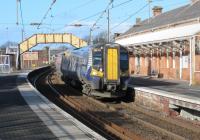
David Panton 17/10/2018
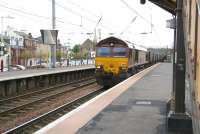
John Furnevel 17/05/2007

Veronica Clibbery 20/06/2011

John Yellowlees 08/07/2016
This station was on a cramped site just east of the B780. It was replaced by Saltcoats [2nd] which was further west. ...
More detailsThis was the second station in Saltcoats which replaced Saltcoats [1st] and was in turn replaced by Saltcoats which is just to the east of its site. ...
More detailsThis junction is marked on the RCH map of 1875. It was the junction for the Ardeer Iron Works, Lucknow Pit and British Dynamite Co Works and Sidings.
...
This is a two platform station. The original station buildings have not survived. The building on the up platform, dating from 1900, was of a style still represented by West Kilbride, although slightly different.
...
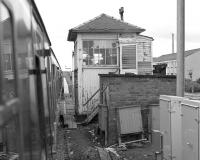
Bill Roberton 31/08/1985

David Panton 12/11/2008
This box controlled access to the Ardeer (Misk) Branch (Glasgow and South Western Railway) and Ardeer Foundry. The box was on the north side of the line immediately to the east of where it was crossed by the Lanarkshire and Ayrshire Railway.
...
This box was east of Stevenston station at the point where the 'new' 1947 spur from the Lanarkshire and Ayrshire Railway met the Ardrossan Railway (allowing closure of the route via Kilwinning East in coming years). The box also controlled the exchange sidings for the Nobel Explosives Works.
...
See also
Ardeer (Misk) Branch (Glasgow and South Western Railway)
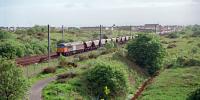
Ewan Crawford //1999
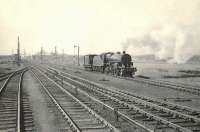
G H Robin collection by courtesy of the Mitchell Library, Glasgow 04/04/1959

R Sillitto/A Renfrew Collection (Courtesy Bruce McCartney) 25/05/1963

Colin Miller //1985
There were two sets of exchange sidings near Ardeer alongside the mainline. Those more distant to the mainline were fenced and associated with the Nylon plant. Access to the sidings was by reversal via a loop on the down line, terminating at the west end close to Stevenston station.
...
See also
Ardeer (Misk) Branch (Glasgow and South Western Railway)
This is a junction between lines from Kilwinning and Irvine for trains to Ardrossan. The Kilwinning route carries a regular passenger service and the Irvine line, single track, is largely used for freight and stock movements.
...
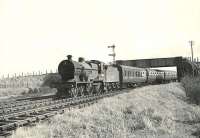
G H Robin collection by courtesy of the Mitchell Library, Glasgow 04/04/1959
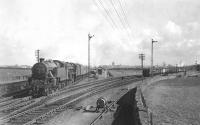
G H Robin collection by courtesy of the Mitchell Library, Glasgow 04/04/1959
The first station in Kilwinning was a terminus at the Byres. This is west of Kilwinning on the road west via Byres to Stevenston. The site was probably subsumed into the Ardrossan platforms at today's Kilwinning station.
...
Doura Branch
This was a substantial branch, with many small branches of its own, serving a myriad of coal mines. At the west end of the branch was the Dirrans (or Dirrens) passenger station to the south of Kilwinning. East from there it served coal workings on the Eglinton Estate and beyond. It was extended and cut back as required to serve these workings. Beyond Millburn (Fergushill Colliery Pit No 19) the route was built at the encouragement of the Glasgow, Kilmarnock and Ardrossan Railway (which had sought to buy the Ardrossan Railway). This extension brought the company into debt and would result in its merging with the Glasgow, Paisley, Kilmarnock and Ayr Railway.
This is a junction between lines from Kilwinning and Irvine for trains to Ardrossan. The Kilwinning route carries a regular passenger service and the Irvine line, single track, is largely used for freight and stock movements.
...

G H Robin collection by courtesy of the Mitchell Library, Glasgow 04/04/1959

G H Robin collection by courtesy of the Mitchell Library, Glasgow 04/04/1959
This was the junction between the Doura Branch of the Ardrossan and Johnstone Railway and the curve onto the Glasgow, Paisley, Kilmarnock and Ayr Railway.
...
See also
Ardrossan Railway
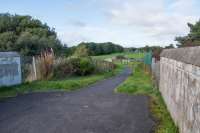
Ewan Crawford 14/09/2017
This junction was between the Ardrossan and Johnstone Railway and the Misk Colliery Branch and was located west of the Eglinton Iron Works and just west of an overbridge of the Glasgow, Paisley, Kilmarnock and Ayr Railway.
...

Ewan Crawford 07/09/2017

Ewan Crawford 07/09/2017
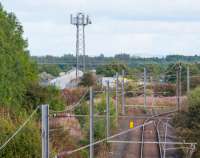
Ewan Crawford 14/09/2017
This was a short lived passenger station on the Doura Branch of the Ardrossan and Johnstone Railway. The station was on the east bank of the River Garnock, which was crossed by a bridge. This station was near a house called Dirrans where the line crossed the Kilwinning-Irvine road. It probably served the Eglinton Colliery and Ladyha Pit which was close by. Also close to the station were a ...
More details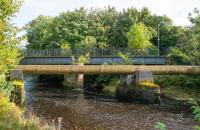
Ewan Crawford 14/09/2017
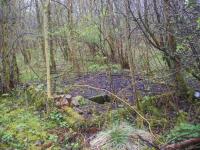
Douglas Blades 23/04/2018
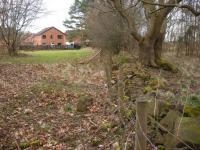
Douglas Blades 09/04/2018
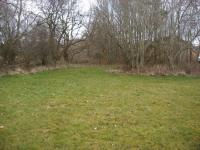
Douglas Blades 09/04/2018
Books











